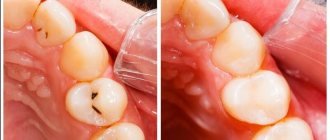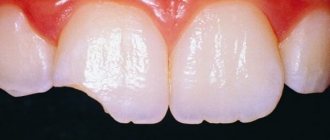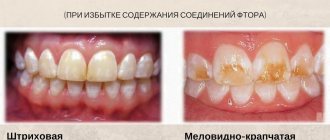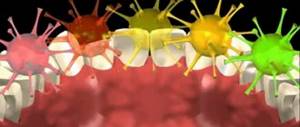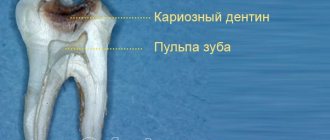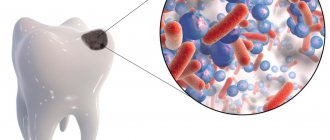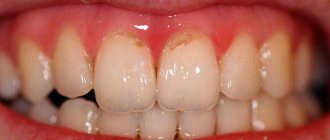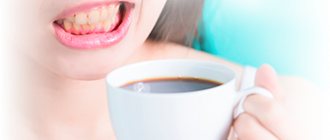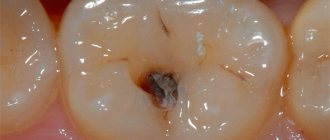To detect caries, dentists use indicators, special substances that stain colonies of carious bacteria - Str. mutans, and the tissues affected by them. In this way, the doctor can understand how damaged the tooth is and what the boundaries of the caries are, as well as whether the defect is a carious lesion. The action of caries markers is to color areas affected by caries. From healthy tissue, the indicator is easily washed off with water without lingering.
What is a Caries Marker and how can it be used to identify lesions?
In some cases, experts separate the concepts of Caries Marker and Caries Detector, believing that the latter is broader and includes not only the substance directly used, but also various other devices and devices that serve the purpose of detecting caries. But there are no discrepancies regarding the concepts of marker and indicator, they are synonyms, it’s just that the first option has taken root better in the dental field.
After the substance has been applied to the affected area, its color changes and the stained tissue is quite easy to detect and then clean with boron. The procedure for applying the marker is carried out until the staining stops, which is a signal that there are no more affected tissues left.
This detector has proven itself excellent in functional diagnostics, as well as in training doctors. It can also serve as an excellent illustration of the current state of affairs to the patient. It is worth noting that although it somewhat reduces the speed of the treatment process, it allows us to leave no doubt about the fact that the therapy was performed efficiently and gave the desired result.
Treatment procedure for caries using a caries marker
Stage 1. Preparing teeth - rinsing with water, drying. The drier the surface, the more intense the color.
Stage 2. Applying an indicator to the enamel surface. Some people use special syringes, while others find it more convenient to work with applicators.
Stage 3. No later than 10 seconds later, the doctor rinses the teeth again with water to remove the paint from healthy areas. The affected tissue remains stained.
Stage 4. Removing caries using a bur machine.
Having removed the layer of tissue, the dentist repeats the staining steps, layer by layer destroying the affected areas. The session lasts until the doctor is convinced that the tissue has stopped staining. This suggests that caries has been completely defeated.
The indicators are practically safe, but patients with hypersensitivity may feel slight discomfort if the solution gets on the mucous membrane. These symptoms will quickly go away when the solution is washed off with water.
Classification of caries detectors and their components
Currently, three groups of caries indicators are actively used in dentistry:
- Chemical markers. The same group, the principle of action of which is associated with applying a certain substance to the surface and painting problem areas.
- Optical markers. Here, a light beam with a length of 405 nm is taken as a basis, and depending on the degree of refraction in the affected area, a color map is displayed on a computer monitor. Accordingly, with this map, the affected areas become clearly visible and the treatment procedure can begin.
- Laser markers. Their operation follows principles similar to optical ones, but instead of a light beam, a laser beam is used.
The last two groups of detectors are distinguished by a high level of convenience, but control over how well the affected area is cleaned by them is more difficult than in the situation with chemicals, moreover, they are very expensive, and not everyone can afford to buy them clinics.
This is why Caries Marker is most often found in dentistry. They usually use synthetic dyes, for example, acid fuchsin or methylene blue, which color problem areas bright red and blue, respectively.
Easy breath
It will also be useful to purchase a breath freshness tester. This is a miniature device that detects alcohol vapor, hydrogen sulfide and other foul-smelling components in the exhaled air, and then shows whether there is bad breath. Different testers refer to this differently. For some, a number from 1 to 5 is displayed on the screen (5 is the strongest smell), for others a green or red light comes on, for others a cheerful or sad face appears on the display. In general, the process turns out to be interesting and quite fun.
However, the tester can hardly be called a toy. If you often get a negative result, this is a reason to consult a doctor. After all, bad breath is often the first sign of many diseases. And not only dental ones, but also those related to malfunction of internal organs - stomach, intestines, liver. Their timely diagnosis provides an excellent opportunity to prevent the disease from progressing and to recover faster.
Instructions for using markers and the principle of their operation
The procedure for using indicators is not particularly complicated; everything is quite simple:
- First, the patient's teeth need to be washed with water and their surface dried, after which a chemical substance is applied to it. To do this, you can use either a traditional syringe or foam balls.
- The drug remains on the surface for a few seconds, no more than 10, after which it should be washed off with water. Those areas that were susceptible to carious infection will appear colored. The intensity of coloring directly depends on the degree of dryness of the enamel: the higher it is, the brighter and more saturated the color will be.
- Removing the affected colored areas with a drill. Next, the treated cavities are treated with the substance again, and if remaining areas of caries are detected, the procedure is repeated again until the markers show a change in color.
Important to know: It is worth considering that the color of not only carious lesions changes, but also plaque and tartar, therefore, you need to be careful in the process of removing tissue.
Such detectors are an excellent aid in the removal of dentin, the infection of which has led to necrosis. This aspect is extremely important, because it is the remains of such tissues, if not noticed and not removed, that can provoke secondary caries that develops under crowns or fillings. That is why the duration of the procedure is quite long, at least half an hour; saving time here is completely inappropriate, otherwise the treatment will not give the desired result.
What are caries markers used for?
A caries marker is used in the following cases:
- to identify residual carious areas after the procedure for removing visible areas of caries;
- to control the result of dentin removal;
- to determine tissue damage in areas inaccessible to visual inspection;
- to show the patient how caries has spread on his teeth;
- for detecting cracks and chips on teeth and in border areas
- to determine the nature of the enamel defect.
A caries marker allows you to detect caries even at the spot stage, penetrating to the depth of the affected area so that the doctor can identify all the dead tissue. By using an indicator, the dentist simply cleans out the stained areas. When the tissue stops staining altogether, the doctor makes sure that the lesion has been removed. Of course, an experienced doctor himself sees the source of caries, but the use of an indicator clearly shows the patient the inflammatory process.
Warnings and Safety Precautions
The main problem that can happen when working with such an indicator is the possibility of staining a healthy tooth. This is quite possible if you leave the substance on the dentin for more than 10 seconds, so dentists usually limit themselves to 6-7 seconds, which is quite enough to detect the problem. Also, this state of affairs implies a refusal to treat a large number of teeth at once; everything needs to be done gradually, in a certain order. In addition, you should be especially careful with the dentin near the pulp, as it has a pink color similar to the color of the marker.
The caries marker does not pose a threat to human health, although those patients who suffer from allergies may have problems with some detectors that contain propylene glycol. The problem is easily eliminated by rinsing with mucus water.
Markers are distinguished by their ability to leave very persistent and difficult to remove marks, especially if this issue is delayed. It is not difficult to remove stains, but only if you do it right away, this is done with a cotton swab dipped in vinegar.
Advantages and disadvantages of application
The technique of caries detection using detectors has several advantages:
- the ability to clearly and extremely accurately separate the boundaries of healthy tissue from those affected by infection;
- absolute safety for human health, which is achieved through the use of natural ingredients as components;
- markers can detect infection not only on the surface of the teeth, but also in the canals;
- Such drugs support the use of invasive type techniques.
We cannot ignore the fact that these indicators also have disadvantages, in particular:
- staining affects not only heavily infected areas, but also those that can be saved with the help of remineralization, but due to the action of the markers, they are simply ground off by a drill.
- The smear layer that appears during the grinding process, different from the others in its color, makes visualization of the work area more difficult, and accordingly, it becomes more difficult to separate healthy tissue from damaged ones.
Composition of indicators
Some patients are mistaken when they believe that such products are dangerous to health, since they contain food dyes, which are used to stain teeth. In reality, plaque indicators are completely harmless to both children and adults. Dyes are easily removed from the surface of teeth and gums by regular brushing with a toothbrush. The food additive E127 is used as a coloring agent, i.e. erythrosine This dye performs its function without penetrating into the hard tissues of the teeth. The composition may also contain various food flavorings so that the plaque indicator products have a pleasant taste and smell, which children especially like.
Prices for Caries Markers from different manufacturers
The cost of indicators can vary greatly depending on the clinic where the treatment will take place, as well as on the manufacturer of the drugs:
- This drug is from Germany, is very popular and has a fairly humane price: for example, 1 gram will cost about 400 rubles, for three grams you will have to pay about one thousand.
- Japanese drug, costs about two and a half thousand for 6 grams.
- Color test. The Russian drug is cheaper than all its analogues - 100 rubles per 20 grams.
The difference in price may be greater, but at the same time, these substances, like a number of others, are quite similar to each other, and doctors give preference to those that are more convenient to work with.
How to use it correctly
Indicators for determining plaque and tartar can be used at any age. Meanwhile, children under 6 years of age should use such products only under the supervision of adults, who should ensure that the child does not swallow the tablet or indication liquid. To determine dental plaque, you need to chew one tablet, distributing it throughout the entire oral cavity; for a child, half a tablet will be enough. If the indicator is in liquid form, then you need to thoroughly rinse your mouth with it. The chewing or rinsing procedure takes no more than one minute. The product should not be swallowed. It is necessary to spit out the product and rinse the mouth with warm water. After this, you can inspect the result. Plaque will be visible immediately. Then the stained areas should be cleaned with a toothbrush and toothpaste.
